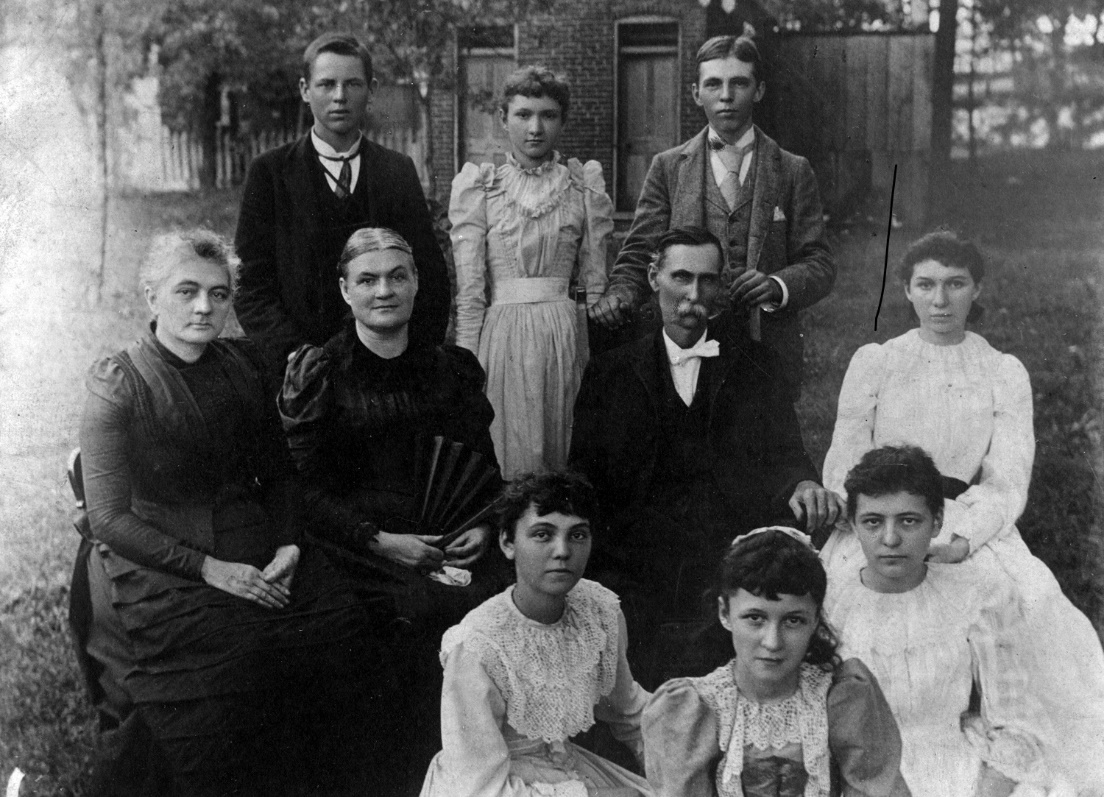The Civil War touched Old Town with the nearby Battle of Franklin in 1864. A short history of Old Town written in 1950 recounted that, “Grandma Brown and the children stood tensely on the upstairs porch during the bloody Battle of Franklin and with saddened and anxious hearts listened with dismay to the booming cannons and the rattle of musketry, while wounded and straggling troops passed along the road.” [5]
The Brown family sought to help the Confederate Army during the war, and “[i]t was commonly understood amongst the Confederate Troops that food was always available at Old Town. A code was worked out by which rocks were placed on the gateposts indicating a point on the farm at which food might be found. Grandma Brown and Bethenia would ride back into the hills with baskets of food to a rendezvous known only to Confederate soldiers.” [6]
The eldest son of Thomas Brown, the original owner, served in the First Tennessee Regiment and later in Coleman’s Scouts. Mr. Brown refused to take the oath after the war and was imprisoned in Nashville for a time.
Excerpt from Virginia Bowman’s book Historic Williamson County: [7]
The war years were hard at Old Town. John Thomas, serving the first in Co. D, First Tennessee Regiment, was wounded at Perryville. He later joined Coleman’s Scouts, was captured and kept at Camp Chase for months. The Negroes left one and two at a time, then one night disappeared altogether. Investigating the deserted quarters, Mrs. Brown found a baby girl abandoned in a barrel. She named her Becky and raised her at Old Town where she was a much loved personage, often figuring in homelife there. When Jane Brown Bowman’s ninth child was born he was named Dunklin Caffey, using the surnames of two Confederate doctors who had saved Mr. Bowman’s arm when he was wounded near Atlanta. When the cook asked what the baby was named, Aunt Becky grumbled in disgust that Miss Jane had had so many children she didn’t care what she named them anymore that she had named this one Dumplings and Cabbages!
Near the close of the war, because he refused to take the oath, Mr. Brown was imprisoned in Nashville where his health was broken in the chill jail. Enfeebled and discouraged, he lived five of the cruel Reconstruction years. He requested that he be buried at South Harpeth with his first wife but when he died January 13, 1870, the Big Harpeth was out of bounds. He was buried in the yard until the roads became passable; his body was then reinterred in the Allison cemetery.
Before he died Mr. Brown divided his property into tracts which were written on pieces of paper and drawn from a hat by his children. John Thomas drew the home-place but because his work was in Nashville, he swapped tracts with Bethenia.
Bethenia Brown Miller lived at Old Town from 1874 through at least 1886.

An entry in the book, History of Tennessee [8], published by Goodspeed Publishing Company in Nashville, TN in 1886 says this about Bethenia Brown Miller and her husband John A. Miller in regards to their tenure at Old Town.
JOHN A. MILLER, a native of Maury County, was born November 25, 1888, and is the son of W.W. and Susan J. (Hadley) Miller. The father is a native of Tennessee, and spent his early life in assisting his father on the farm and in attending the common schools. He is a member of the Baptist Church. The mother died at her residence in Maury County in 1883. Our subject, in 1855, entered the Jackson College, at Columbia, Tenn., where he finished his education. May 1, 1861, Mr. Miller enlisted in Company G, First Tennessee Infantry, and participated in the battles of Shiloh, Chickamauga, and other engagements. In 1864 Mr. Miller was captured and carried to Fort Delaware, where he was paroled December 6, 1865. After the war he engaged in farming, and in December 1866, he was married to Miss B.A. Brown, daughter of Thomas Brown, of Williamson County, Tenn., who was born in Virginia, near the old battle-field of Manassas. In early life, he immigrated to Tennessee, locating near Nashville, and at the age of twenty-nine he married Miss Nancy Allison, of Davidson County, and after her death was wedded to Mrs. Hunter. Mr. Brown died in February, 1870, and was a worthy member of the Christian Church. To our subject and wife were born six children: John, Maggie B., Thomas B., William W., Joe A.B. and Mary M., deceased. January 1, 1874, he moved to the Sixth District of Williamson County, to the farm known as “Old Town,” where he now resides. Mr. Miller is a member of the Presbyterian Church and of the Masonic fraternity, and is a Democrat in politics.
Cultural Context of the Civil War Historical Period [9]
Civil War and Reconstruction (1861–1885)
After the evacuation of Atlanta in 1864, General John Schofield took command of the 4th and 23rd Army Corps with the mission of slowing the progression of Confederate troops, led by Lt. General John Bell Hood, from northern Georgia to Nashville. On the evening of November 29, 1864, the Union troops passed their enemies at Spring Hill and entered Franklin, occupying a series of earthen fortifications on the south edge of town. The next day, when Hood realized the Union army had passed his troops, he immediately marched the Army of Tennessee north toward Franklin. Upon their arrival at Winstead Hill, just south of Franklin, Hood initiated a frontal assault on the Union army. At 4:30 in the afternoon, the Army of Tennessee organized a threemile battle line of 23,000 Confederate soldiers along the Columbia Pike. As the Union troops fled, the soldiers in Generals John C. Brown’s and Patrick Cleburne’s divisions smashed into the earthworks created by the Union army (Craddock 2009).
The federal soldiers succeeded in forcing the Confederate soldiers toward the outer ditch of the main earthworks. Overall, the Confederate soldiers attempted nearly 18 charges without significantly penetrating the Union defense. The battle lasted until 10:00 in the evening. Schofield quickly marched his men toward Nashville (Craddock 2009; Goodsell 2009; Harper 1972; McKithan 1982).
Nearly 7,000 Confederate soldiers died, while the Union army lost approximately 2,500 soldiers. Of the 100 Confederate regimental commanders, 63 were killed or wounded. Six Confederate generals were killed, five were wounded, and one was captured by the Union army. The massive Confederate loss at the Battle of Franklin weakened the Army of Tennessee, rendering them ineffective at the Battle of Nashville two weeks later (Craddock 2009; Harper 1972).
After the Civil War ended in 1865, the county was slow to recover due to the extensive damage during the Battle of Franklin, the collapse of slavery, and the political upheaval associated with the Reconstruction Era. In 1880, the county’s population was 28,313 (Acuff 2010).
Sources:
5. Goodpasture, Henry and Virginia, Old Town, 1950, pp. 16 – 17.
6. Goodpasture, Henry and Virginia, Old Town, 1950, pp. 15 – 16.
7. Bowman, Virginia McDaniel. “Old Town.” Historic Williamson County, Blue & Gray Press, Nashville, 1971, pp. 91-93.
8. History of Tennessee, The Goodspeed Publishing Company, Nashville, Tennessee, 1886, pg. 997.
9. Geophysical Survey of Old Town Archaeological Site (40WM2) Williamson County, Tennessee by New South Associates, Inc., Sarah Lowry (Principal Investigator), September 20, 2019.
